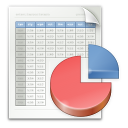Date and Time Formats
Gnumeric and Goffice need to know how dates and times are usually written in a locale. We do that using translations of a handful of strings like "*Long Date Format" and "*Short Time Format". These strings should be translated to Excel format codes representing the right format. If that makes no sense to you, drop a line on the mailing list and we'll help out.
Most of these have reasonable defaults if you do not translate them or translate them to the empty string. In fact, if the default works fine, please translate to an empty string. You can try out a given format in Gnumeric:
- Enter "1-Feb-2009" into cell A1.
- Select A1.
- Press Ctrl-1.
- Select "Custom" and enter the format you wish to try.
Wikipedia has a good overview of date and time formats by country.
Long Date Format
This is the most important format to translate because there is no good default for this. The US version of this is "dddd, mmmm dd, yyyy" which translated to something like "Saturday, January 01, 2000".
Medium Date Format
This defaults to "d-mmm-yyyy".
Short Date Format
This defaults to "m/d/yy", "d/m/yy", or "yy/m/d" depending on whether the OS tells us that month, day, or year should come first.
Short Date/Time Format
This consists of two parts: a date and a time. The date part defaults to the short date format. The time part defaults to the short time format.
Long Time Format
This defaults to "h:mm:ss AM/PM" or "hh:mm:ss" depending on whether the OS tells us that a 12 or 24 hour clock is in use. Note, that the 12-hour clock will use a single digit for the hour if possible.
Medium Time Format
This defaults to "h:mm AM/PM" or "hh:mm" depending on whether the OS tells us that a 12 or 24 hour clock is in use. Note, that the 12-hour clock will use a single digit for the hour if possible.
Short Time Format
This defaults to "hh:mm" which is probably ok for most locales.
